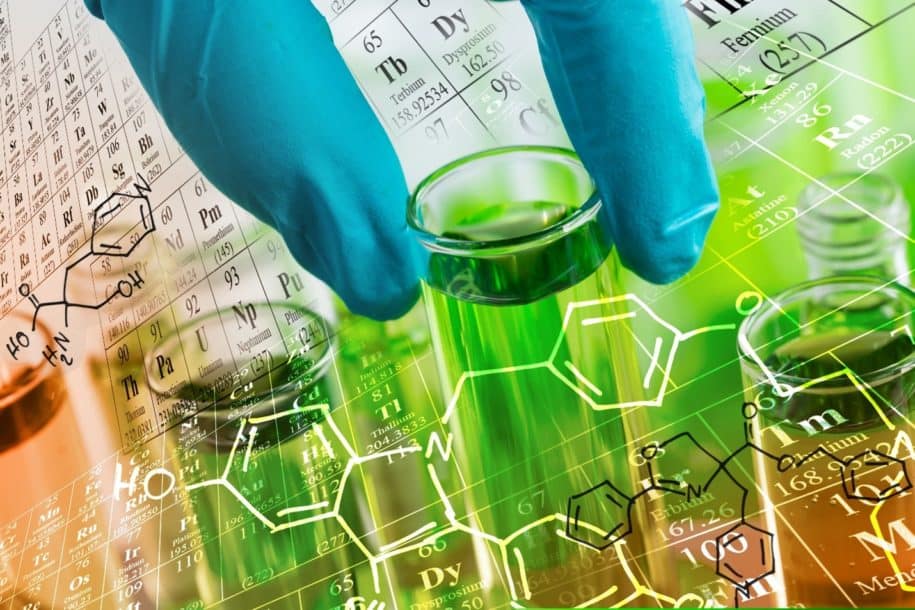Chemicals are used in industries to create many products and materials, but when they are handled improperly, they have an inherent potential to cause great harm. Chemical exposures affect the body in two ways, resulting in either a chronic health effect or an acute physical effect. Chronic health effects occur after a chemical has been inhaled or ingested over a long time. For example, an organic solvent when used occasionally, may irritate the eyes, nose, and throat, and still not cause health effects. However, if someone were to be exposed to the same solvent for a long duration for many years, it could result in long-term health effects on the body. Acute physical effects are referred to when a chemical could cause immediate injury to the body. Corrosive substances, flammable liquids, compressed gases, and toxic substances represent examples of chemicals that pose physical hazards.
Chemicals also have the potential to produce detrimental effects from reactivity. Reactivity is the ability to undergo a chemical reaction with the introduction of another material or substance. This could produce harmful by-products and damage people and property. If not managed properly, reactive chemicals could release noxious gases, produce fires, and even cause explosions. The reactions may be violent, explosive, or cause long-term damage to the environment and health issues for those exposed.
Chemical incompatibility reactions are a common cause of workplace injury and illness. The severity and scale of accidents involving incompatible chemical reactions are determined by the type of chemicals and the quantities of the chemicals involved. The main cause of such incidents is the lack of awareness regarding a chemical’s properties (and the dangers of mixing it with certain other substances). While training employees on the inherent hazards of chemicals, employers must ensure that employees are also educated about the incompatibility and reactivity hazards of chemicals being used in work. Though they can be hazardous, chemical incompatibility reactions can be prevented with proper training and preparation.
When the following common chemicals are stored together or accidentally mixed, they can react to form heat, generate pressure, or release harmful gases:
- Hydrogen peroxide when mixed with vinegar produces a highly corrosive acid called Peracetic acid. The fumes released from this acid could result in irritation of the eyes, skin, and respiratory system.
- When common household agents such as bleach are mixed with ammonia, chloramine is produced. Chloramine is an irritant that smells like chlorine and triggers irritation in the eyes, skin, and mucus membranes. In high doses, chloramines could cause acute respiratory distress.
- Bleach mixed with alcohol creates chloroform. Chloroform is a powerful anesthetic and sedative. Accidentally inhaling chloroform could cause loss of consciousness.
- There have been several incidents resulting from the accidental mixing of bleach and vinegar. Combining these chemicals creates chlorine gas. Chlorine is a toxin that affects the respiratory system and produces stinging irritation in the eyes and skin.
The Hazard Communication Standard (HCS) in the United States, the Control of Substances Hazardous to Health (COSHH) in the United Kingdom, and the Workplace Hazardous Materials Information System (WHMIS) in Canada all require employers to identify and label chemicals in the workplace and train employees on their safe use. Provision of the following processes and information is also required of employers:
- Training to educate employees on recognizing hazards associated with chemicals.
- Safety Data Sheets (SDS) for each chemical used in the workplace and training for employees to be able to read and understand the content.
- A hazard communication program to protect employees from exposure to hazardous chemicals.
Managing the essential information for a multitude of chemicals used at a facility and communicating the associated chemical hazards could become a daunting task for an organization, especially when operations are spread out over several departments, buildings, locations, etc. Additionally, due to the volatile and critical nature of chemical hazards, information needs to be kept as up to date as possible. Therefore, establishing an ideal hazard communication and chemical management system requires the identification and utilization of digital tools to provide employees quick access to life-saving information.
Author Bio
The SafetyStratus Research Advisory Group (RAG) brings together thought leaders from the global environmental, health, and safety community to promote best practices and provide key insights in the profession and the industries they serve. The Research Advisory Group also advocates, where practical, the intersection of and advances with the use of technology, such as the SafetyStratus enterprise EHS software platform. Group membership consists of representatives from across varied disciplines and market sectors as well as select members of the SafetyStratus team.
The primary objectives of the SafetyStratus RAG partnership are to:
- Build a strategic partnership between EHS practitioners and the SafetyStratus team.
- Provide engaging and practical content to the global EHS community.
- Provide discipline and market feedback specific to SafetyStratus products and services.
While the objectives of the RAG are varied, the primary public-facing outcome will be available through engaging and practical content found on the SafetyStratus resource pages. Various articles, papers, and other valuable resources will be produced and shared as part of an ongoing effort to cultivate a robust community. Ultimately, the SafetyStratus RAG will expand to have a broader reach and provide opportunities for more inclusion by all interested EHS professionals in a collaborative community environment.



